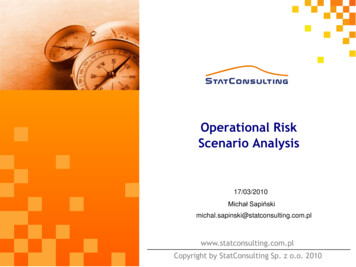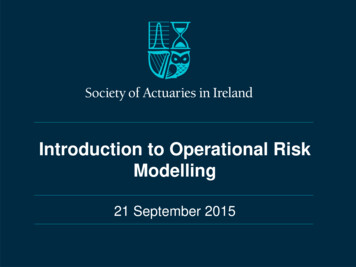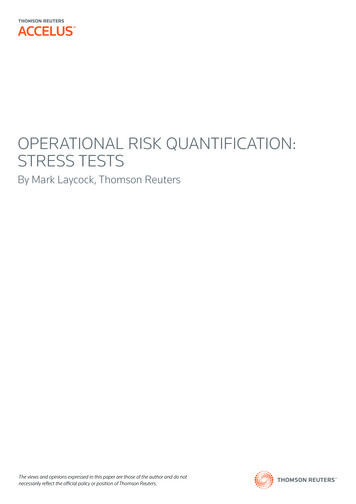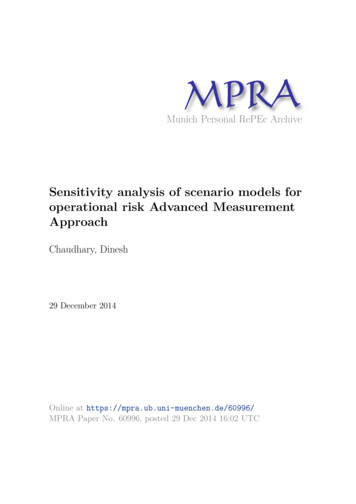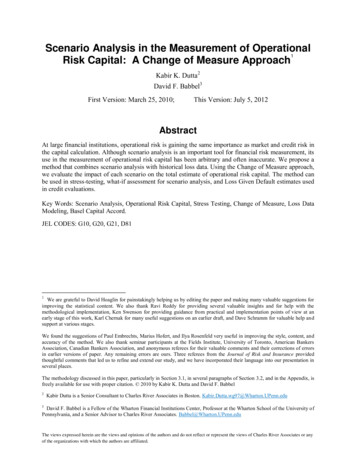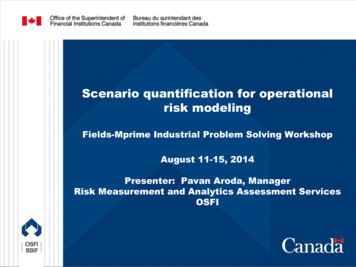
Transcription
Scenario quantification for operationalrisk modelingFields-Mprime Industrial Problem Solving WorkshopAugust 11-15, 2014Presenter: Pavan Aroda, ManagerRisk Measurement and Analytics Assessment ServicesOSFI
DisclaimerAll views expressed in this presentation are those of my own and do not represent the views of OSFI.The problem put forth and the ensuing proposed solution does not signal that OSFI has adopted thepreferred method.Within the presentation, no confidential information of supervised financial institutions has beendisclosed. Any information has been sourced from publically available sources (e.g. supplementaryfinancial information) with references stated where applicable.Any and all errors are that of my own.2
Agenda1. Introduction of organization and banking regulation2. Primer on regulatory capital and risk types3. Focus on Operational Risk4. Proposed problem: Scenario quantification for operational riskmodeling5. Recap and benefits of the workshop3
1. Introduction of organization andbanking regulationOSFI Independent agency of the Government of Canada, establishedin 1987 to contribute to the safety and soundness of theCanadian financial system. OSFI supervises and regulates federally registered banks andinsurers, trust and loan companies, as well as private pensionplans. Recently, CMHC has come under OSFI supervision. Offices in Vancouver, Ottawa, Toronto and Montreal. Employs approximately 660 people.4
1. Introduction of organization andbanking regulationMandate Supervise federally regulated financial institutions and pensionplans to determine whether they are in sound financial conditionand meeting minimum plan funding requirements respectively,and are complying with their governing law and supervisoryrequirements. Promptly advise institutions and plans in the event there arematerial deficiencies and take or require management, boards orplan administrators to take necessary corrective measuresexpeditiously. Advance and administer a regulatory framework that promotesthe adoption of policies and procedures designed to control andmanage risk. Monitor and evaluate system-wide or sectoral issues that mayimpact institutions negatively.5
2. Primer on regulatory capital and risktypesRegulatory capital: loss-absorbing elements that count ascapital (valuable assets) that provides a buffer to protectdepositors. Examples: common shares issued by bank,retained earnings, other compressive income etc.Regulatory capital provides a buffer against unexpected loss.ProbabilityValue-at-Risk (VaR)Expected LossUnexpected Loss(EL)(UL)Loss6
2. Primer on regulatory capital and risktypes Capital ratios are of broad interest to regulators and banks. They arecomputed as:capital ratio capital / risk weighted assets Capital: three main types; ordered by “quality”: common equity tier 1is of higher quality than tier 1 which is of higher quality than totalcapital. Risk weighted assets (RWA): assets of banks weighted according toriskiness. Higher RWA attracts more risk and more capital.Capital ratiotype2014 Minimumcapital required2014 Targetcapital targetCET14.0%7.0%Tier 15.5%8.5%Total capital8.0%10.5%7
2. Primer on regulatory capital and risktypes International convergence of capital measurement and capitalstandards was seen as a necessity and hence Basel I was createdin 1988 from a group of central bankers around the work (theBasel Committee of Banking Supervision – BCBS). The group isone of many committee which fall under the Bank of InternationalSettlements (BIS) in Basel, Switzerland. Basel II was published in 2004, a 2.5 version in 2009, and nowBasel III in 2011. Each iteration has become more prescriptiveincorporating lessons learned and advancement. There arealready consultations on a new iteration 3.5 or 4? OSFI takes the Basel guidance, interprets or modifies theguidance and publishes its version called capital adequacyrequirements (CAR) and uploads it on the OSFI public websitesfor institutions to reference.8
2. Primer on regulatory capital and risktypes Three types of broad risk types: Market risk: The risk of losses in on-and off-balance sheetpositions arising from movements in market prices. The riskspertaining to this requirement (for instruments in the trading book):interest rate risk and equity position risk; (throughout theinstitution): foreign exchange risk and commodities risk. Credit risk: The risk that a bank borrower or counterparty will failto meet its obligations in accordance with agreed terms (e.g. aloan). Operational risk: The risk of loss resulting from inadequate orfailed internal processes, people, systems or from, external events.Includes legal risk, but excludes strategic and reputational risk.Source: definitions from OSFI CAR/BCBS9
2. Primer on regulatory capital and risktypes Sense of scale: MillionBMOBNSCIBCRBCTDAverageCET1capital (A)22,34028,49913,34732,99827,803-Credit tRisk RWA14,49416,7144,17044,05513,1777%OperationalRisk RWA26,77932,16017,78743,89835,82412%Total RWA(B)240,076302,070140,505341,752312,972100%CET1 ratio(A/B)9.39.49.59.78.9-Source: Publically disclosed on each bank‟s website - Q1 2014 InvestorRelations - Supplementary Financials10
2. Primer on regulatory capital and risktypes Choices for RWA: standardized method vs. advanced method. Standardized capital intensive, risk insensitive, “look uptable”. Market: based on rating, maturity bucket - capital charge multiplier*exposure. Credit: set risk weights based on loan type *exposure. Operational: set multiplier*gross income.11
2. Primer on regulatory capital and risktypes Advanced “maybe” hold less capital, risk sensitive,sophisticated.aside Market: max{VaRt-1; mc*VaRavg} max{stressed VaRt-1 ; ms*stressed VaRavg} mc, ms multiplier floored at 3 (prescribed by regulator) VaR Value-at-Risk, 1-tailed, 99% c.l., 10 day holdingperiod. Credit: Vasicek (1991) asymptotic single-risk factor (ASRF) Modeled PD, LGD, EAD as inputs. 99.9% c.l., exceed capital on average once in a thousandyears. Operational: advanced measurement approach (AMA) Based on loss distribution approach (LDA) from actuarialfield with other modeling elements. Value-at-Risk, 1-tailed, 99.9% c.l., exceed capital onaverage once in a thousand years. RWA capital*12.5 (reciprocal of the minimum capital ratio of8%; slight modification for credit risk RWA).12
3. Focus on Operational RiskOperational risk – why all the fuss? Impact on bank‟s bottom line, New complex financial products and strategies, Increased reliance on rapidly evolving technology, Globalization, Regulatory activism, growing litigation, Growing area of research; need to advance field of study. Motivation for later on The bank is now testing a variety of new models and methodologiesto get a better handle on where the economy is headed, and updatingits forecasts eight times a year.“We are working hard to refine those models, but this experience isalso leading us to put increase emphasis on anecdotal evidence –real conversations with real Canadians making economic decision.”Source: Globe and Mail, March 28, 2014, Bank of Canada Governer Stepehn Poloz13
3. Focus on Operational RiskNotable Operational Risk Events (Global)(2013) JPMorgan Chase - over 8bn USD - London WhaleAug 14 2013 - 'London whale' traders charged in US over 7bn lossSep 19 2013 - JP Morgan fined 920m over 'woefully deficient' London Whale controlsTrader Bruno Iksil, nicknamed the London Whale, accumulated outsized CDS positionsreportedly as part of the bank's hedging strategy. Strategy was "flawed, complex, poorlyreviewed, poorly executed, and poorly monitored".(2012) Busan Savings Bank internal fraud - 4.29bn USDJun 19 2012 - Korean bank scandal prompt suicidesBusan Savings Bank and its subsidiaries were making bad loans to more than 100 realestate and construction companies in South Korea. The bank’s executives, includingchairman Park, were detained for illegal loans and fraud. The Governor of the FinancialSupervisory Service (FSS) were also found guilty for illegally holding a stake in the Bank.(2011) UBS rogue trader- 2.3bn USDThe director of the bank’s Global Synthetic Equities Trading team in London conducted aseries of unauthorized trades, disguising the risk with fictitious, forward-settling, cash ETFpositions.(2011) 77 Bank tsunami loss - 378.24mn USDThe tsunami that hit Japan last year caused 77 Bank, a regional bank in Sendai, to suffera great loss due to physical damages and unrecoverable loans.14
3. Focus on Operational RiskSpectrum of approachesAdvancedMeasurementApproach (AMA)StandardizedApproach(TSA)Basic IndicatorApproach (BIA)15
3. Focus on Operational RiskBasic Indicator Approach (BIA) Capital charge is based on the 3-year average of a fixedpercentage ( ) of positive gross income (GI).Capital charge [ 𝑛𝑖 1 (GI𝑖x )]/nGI net interest income net non-interest income asdefined by national supervisors and/or national accountingstandards.Exclude years of negative gross income. 15%.Generally used as a default op. risk capital charge.16
3. Focus on Operational RiskBasic Indicator Approach (BIA) Exclude years with negative gross income.GI ( B)Year 180Year 2-20Year 3120TotalAveragex 15% ( B)121830Total / 2 15 B17
3. Focus on Operational RiskThe Standardized Approach (TSA) Activities mapped to 8 Basel II business lines. Capital charge for each business line calculated by multiplying grossincome by the factor ( ) for that business line ( factors are distributedaround ).Capital charge { years 1-3 max[ (GI1-8 x 1-8),0]}/3 Total capital charge is the average of the simple summation of thecapital charges across all business lines in each year of the preceding3-year period. Unlike the BIA, the denominator must always be set to 3 (allows a bitof a break – granularity).18
3. Focus on Operational RiskThe Standardized Approach (TSA)Business LinesBeta ValueCorporate Finance18%Trading & Sales18%Retail Banking12%Commercial Banking15%Payment & Settlement18%Agency Services15%Retail Brokerage12%Asset Management12%19
3. Focus on Operational RiskThe Standardized Approach (TSA)Year 1Gross income ( B)x BetaTotal ( B)Business Line A6012%7.2Business Line B-1015%-1.5Business Line C3018%5.4Total80Year 2Gross incomex BetaTotalBusiness Line A3012%3.6Business Line B-4015%-6.0Business Line C-1018%-1.8Total-20Year 3Gross incomex BetaTotalBusiness Line A8012%9.6Business Line B1015%1.5Business Line C3018%5.4Total12011.1Capital charge 11. 1 0 16.53 9.2 B-4.216.520
3. Focus on Operational Risk2. External data1. Internal loss data4. Business environmentinternal control factors(BEICF)3. Scenario analysisCorrelationRisk mitigationAMACapital requirement21
3. Focus on Operational RiskData collection: 8 business lines, 7 event types 56 units of actices andWorkplaceSafetyClients,Products sruptionandSystemFailuresExecution,Delivery &ProcessManagementCorporateFinanceTrading &SalesRetailBankingCommercialBankingPayment okerage22
3. Focus on Operational RiskBank treatment of op. risk lossesLowBudget,Expense,Reserve,Capital„Beafraid bevery er,Reserve,CapitalSeverityHigh23
3. Focus on Operational Risk1. Internal loss data Usually loss data collected for a minimum of 5 years. Losses collected above a threshold of 10,000 USD. Losses booked into a central database by risk officers ineach business line. Record date of occurrence, date of discovery, date ofsettlement, gross loss, recoveries, etc. Not all 56 units of measure will have sufficient data points tocalibrate model (usually about 50-100 data points minimum).24
3. Focus on Operational Risk2. External loss datai. Vendor databases (e.g. SAS OpRisk and Algo OpRisk) Compiled from public data and have a story-line approach todescribing losses. Taken from newspapers, court records,journals etc.ii. Consortia databases (e.g. ORX) Give-and-take basis allowing banks to contribute operational lossdata in order to receive in return anonymized loss data from peersgroups.25
3. Focus on Operational Risk2. External loss dataVendor; As of 2012SAS OpRiskAlgo OpDataTotal number ofobservations22,00012,000Industries covered2120Financial services covered6,3614,519Loss threshold 100,000 1,000,000First year of losses19711972Consortia; As of 2012ORXTotal number ofobservations160,000Severity of losses 55 billionMember banks54First year of losses2002Loss threshold 20,000Source: http://www.sas.com/en data/http://www.orx.org/Pages/HomePage.aspx26
3. Focus on Operational Risk Loss aggregation approachesi) Analytic approach The single loss approximationii) Numerical approach The FFT approach The Panjer recursioniii) Simulation based approach The Monte Carlo approachMost popularized method is the MC method27
3. Focus on Operational RiskMonte Carlo Method Perform loss aggregate by modeling separately frequency andseverity of losses.Sk 𝑁𝑘𝑖 1 𝑋𝑘 , 𝑖 k 1 m, where m 56 usually (S1, S2, , S56). 𝑁𝑘 frequency distribution (each cell may have different dist.). 𝑋𝑘,1, xk,𝑁 k random draws of the severity distribution Xk (eachcell may have different dist.).1.Draw from frequency distribution a number N which represents thenumber of occurrences a loss is to occur for a cell,2.Draw N realizations from severity distribution,3.Sum all the N losses to obtain an aggregate loss for the year,4.Repeat steps 1 to 3 many times (ex. 1million),5.Pick up the 99.9% percentile as op risk capital.28
3. Focus on Operational Risk Frequency - popular choices are: Poisson, Negative Binomial. Severity - popular choices are: Log-normal, Log-gamma, Loglogistic, Burr, Generalized Pareto, Weibull.How to chose best severity distribution? – Goodness of fit tests Kolmogorov-Smirnov (KS) Test: Compares the empiricaldistribution function (EDF) with the cumulative distributionfunction (CDF) of the assumed distribution. The KS statistic isthe maximum distance between the two curves. Anderson-Darling (AD) Test: Modified KS test to give moreweight to the tail. Probability Plot: Graphical technique for assessing whether ornot a sample follows a hypothesized distribution. Quantile-Quantile Plot: Similar to the PP plot, but determineswhether two samples come from the same distribution. Etc.29
3. Focus on Operational Risk3. BEICF Firm-wide risk assessment methodology must capture keyfactors that are forward-looking and reflect quality of abank‟s control and operating environment. Many options! May design a customized scorecard thatassigns a point system to each factor across business linesor some level of granularity. BE: comment on products, strategy, business cycle,volumes, regulatory environment etc. ICF: comment on people, processes, systems, audit scores,etc. Tally points assigned above, depending on final score,assign capital adjustment of anywhere from -10%, 0, 10%. Usually applied on top of model incorporating loss data andscenarios.30
3. Focus on Operational Risk4. Scenarios! “A bank must use scenario analysis of expert opinion inconjunction with external loss data to evaluate its exposure tohigh-severity events.” “ draws on the knowledge of business managers to derivereasoned assessments of plausible severe losses”. “ could be expressed as parameters of an assumed statisticalloss distribution”. Only one paragraph to go on!Source: OSFI CAR Chapter 8, par 6331
3. Focus on Operational Risk4. Scenarios! Used to provide a “forward looking view”. Used in places of data scarcity.Range of practice Some Australian and European banks (Italy, Germany) havescenario-based AMA models. US has less comfort with scenarios used directly in model (put intoa benchmark model instead). Canada acknowledges best-practice with sufficient justification.32
4. Proposed problem: Scenarioquantification for operational risk modelingProblem: How best should scenario workshops be conducted inorder to elicit necessary and sufficient information to formulatescenarios for modeling?How should questions be framed? What are realistic questions toask on frequency and severity?What sort of data should be referenced in order to guide scenariorespondents?How can scenarios be updated/refreshed over time to ensuretheir reasonableness?Are scenarios a valuable element for AMA modeling?33
4. Proposed problem: Scenarioquantification for operational risk modelingResearch Chaudhury (2010) discusses the key issues in operational riskcapital modeling. Good coverage of the open problems with AMAmodeling. Khaneman and Tversky (1979) introduce Prospect Theory whichconcerns decision making under conditions of risk. Empirically showed respondents underweight outcomes that weremerely probable in comparison to outcomes that were obtained withcertainty. Real-live workshops showed a preference for a sure gain over alarger gain that was merely probable. Rather than accept a smaller loss with certainty, participantspreferred to take on risk and gamble on a loss what was merelyprobable but larger in loss magnitude.34
4. Proposed problem: Scenarioquantification for operational risk modelingResearch Ergashev (2012) points to quantifying scenarios with an orderedpair: frequency estimate that represents a worst-in-a-M-yearevent and a severity estimate that represents a lower bound ofloss amount. Does not go into detail how to arrive at „M‟ or lowerbound. Rather paper goes on to test if scenario moves the riskprofile of the base LDA model by imposing a lower boundconstraint on the severity distribution. Dutta and Babbel (2010) introduce Change of Measure approachto integrate scenarios. Starting from the point of a frequencyestimate of 1 in N years and severity in a range [a,b], outlinesmethods to adjust baseline LDA model to incorporate scenarios.Does not suggest how to elicit N of [a,b]. However, does say tolimit N to a 100 year event for methodology stability. One possible method to incorporate scenario as raw estimatedirectly.35
4. Proposed problem: Scenarioquantification for operational risk modelingResearch Shevchenko and Wüthrich (2006) introduce method ofcombining loss data with expert opinions via Bayesianinference. Aside from main result of paper, points to ad hoc procedure toincorporate scenarios that are fitted to distribution:w1FSA (X ) w2FI (X ) (1 w1 w2 )FE (X ) Alternative method to simply integrate scenarios as adistribution Paul Embrechts and Eric Cope along with fellow collaboratorsare highly published and regarded in the operational riskcommunity. Numerous papers of relevance.36
4. Proposed problem: Scenarioquantification for operational risk modelingIssue: Banks unwilling to share operational loss data (confidential). Select publications that do exist mask identity of bank; also scaledata. “It is ORX policy to work with industry and academic partnerswhere appropriate and through an open selection process. If youare interested in a research partnership with ORX then pleasecontact:Dr. Luke CarrivickHead of Analytics and ResearchORXEmail: luke.carrivick@orx.org “ Other innovative methods? Simulated data?37
4. Proposed problem: Scenarioquantification for operational risk modeling Perhaps phrase the problem in terms of weather? http://climate.weather.gc.ca/. Data readily available on rainfall,snowfall. Extension to catastrophic events such as tornadoes,hurricanes (low frequency/high severity)? Occurs withsomewhat random frequency and varying severities. Tailevents. Develop baseline LDA model; reference data of neighbouringcities; develop scenarios. If results seems tractable, reach out to data consortium/banks,publish results?38
5. Recap and benefits of the workshop Introduced banking regulation and the numerous areas wheremathematical and statistical models are needed and used. Narrowed the focus to operational risk in order to spurresearch and seek answers to open questions. For the AMA model, looking to apply a structured mathematicalprocess to elicit scenarios and also calibrate and integratescenarios. Value-add through publication and/or guidance to the industryin terms of potential new regulatory policy. OSFI continually hires mathematical/statistical candidates(MSc, MA, PhD, CFA, FRM etc.). Two potential positionsopening up in 2015 in RMAAS group – look for it!39
ReferencesChaudhury, Mo. (2010). A Review of the Key Issues in Operational Risk CapitalModeling. The Journal of Operational Risk. Vol 5. No 3. 37-66.Dutta, K.K., and Babbel, D.F. (2010). Scenario Analysis in the Measurement ofOperational Risk Capital: A Change of Measure Approach. Working Paper, University ofPennsylvania,Philadelphia, PA. URL: shev, B.A. (2012). A theoretical framework for incorporating scenarios intooperational risk modeling. Journal of Financial Services Research. Vol 41. 145-161.Kahneman, D and Tversky, A. (1979). Prospect Theory: An Analysis of Decision underRisk. Econometrica. Vol 47. No 2. 263-292.Shevchenko, P.V., and Wüthrich, M.V. (2006). The structural modeling of operationalrisk via Bayesian inference: combining loss data with expert opinions. The Journal ofOperational Risk. Vol 1. No 3. 3-26.40
Questions?Pavan ArodaEmail: pavan.aroda@osfi-bsif.gc.ca
Scenario quantification for operational risk modeling Fields-Mprime Industrial Problem Solving Workshop August 11-15, 2014 Presenter: Pavan Aroda, Manager . Scenario analysis 4. Business environment internal control factors (BEICF) Capital requirement Correlation Risk mitigation 3. Focus on Operational Risk

